
Towing capacities, tongue weight, payload, receivers, balls, spacers, pins—André breaks down the different types of hitch systems available for bumper pull towing mounts for your truck, SUV, or crossover. Whether you’re pulling a U-Haul trailer with your wagon or 20,000 pounds with a 1-ton truck, André will show you how it’s done.
The first step is to determine how much your vehicle can tow. A check of the owner’s manual will tell you what your vehicle’s max tow rating is AND its max payload.
Up to 3,500 LBS

The smallest hitches fit 1.25-inch receivers commonly used on cars and crossovers. At their smallest, they have a weight rating of up to 3,500 pounds with a 350-lbs. tongue weight. Most can be used so they have a drop of several inches or set up to have a rise (see photo above). This allows them to be used on cars with a low hitch height in order to help level out the trailer.
Payload is one of the most important numbers to factor into your vehicle’s towing capability. That’s because the tongue weight of your trailer will subtract from your vehicle’s total payload.
Example: A SUV has a payload of 1,000 pounds and a towing capacity of 5,000 pounds. A rule of thumb states that a 5,000 pound towing capacity translates to a 500 pound tongue weight. So if you’re towing 5,000 pounds, the payload of the SUV is now only 500 pounds, meaning that instead of carrying 4 adult passengers who weigh 175 pounds each, you can now only carry two passengers safely.
Up to 7,500 Lbs.
Hitches rated to tow between 3,500 to 7,500 lbs. are the most popular. At the low end, they’ll see use on smaller mid-size trucks and SUVs rated to tow 5,000 pounds. At the top end, they see use on half-ton pickups such as the Ford F-150 or Chevy Silverado 1500 and full-size SUVs like the Chevy Tahoe or Ford Expedition. They can handle 5,000- to 7,500-pounds of trailer and load, which is usually plenty to move boats, ATVs, and campers.

At this level hitches start to get interesting with a variety of options including adjustable hitches that allow you to get the perfect level set-up between your trailer and vehicle. You can see the simple Curt option below as well as the new Gen-Y Glyder adjustable hitch shown below adds a torsion axle (Gen-Y Hitch is a TFLtruck partner). This allows for vertical movement of the trailer, making for a smoother connection between trailer and vehicle.
Up to 10,000 Lbs.
Once you move up to loads in excess of 7,500 pounds you’re driving a properly setup 1/2-ton truck. These are still 2-inch hitch receivers, but the hitches themselves are more solid and the hitch balls go from 2 inches in diameter to 2 and 5/16th inches.
More than 10,000 Lbs.
At these weights, we’re talking about truly heavy duty and commercial-grade hitches that top out with the 1-ton dually HD trucks with 3-inch receivers that can haul over 20,000 pounds. But to make his point, André uses the Gen-Y Boss, a supremely adaptable torsion flex hitch for a 2.5-inch receiver that’s rated to 16,000 pounds. The Boss accepts weight-distribution attachment to spread the load more evenly across all axles of the truck and trailer. It can even convert into a pintle hitch for use with off-road or other commercial trailers.

Weight-Distribution Hitches(WDH) – For loads over 5,000 pounds, utilizing a weight distribution hitch is a safe and smart move. These hitches use arm extensions to spread the mass on the tongue and *push* the weight of the trailer farther forward on your vehicle. The result is a more balanced and level load that’s easier to control. We recommend the use of the WDH with body-on-frame SUVs and trucks.

Adapters and Other Accessories
A simple sleeve adapter allows you to fit a 2-inch hitch into a 2.5-inch receiver. It’s a simple and affordable solution, but it does reduce the total capacity of your hitch. That’s due to the sheer force of the adapter on the pin holding your hitch in place.

A hitch extension allows users to run their hitch beyond a tailgate that needs to be left down for a long load or, more commonly, to reach past a camper that extends past the truck bed. One word of caution: The longer your hitch extension the lower your maximum tow rating.

Pintle hitches are used for off-road trailering and big commercial applications. Instead of a ball, they use a hoop to enable for articulation between the trailer and the vehicle. Because of their range of motion, though, they offer less control over the load than you’d enjoy with a traditional ball set-up.
To see all these hitches in action, click on the video below. Bonus! You’ll get to see some of André’s favorite hitch receiver plug-ins.




















![Which is More Reliable: 3.5L EcoBoost or 5.0L V8? [Reader Question] Second-generation 3.5-liter EcoBoost engine](https://tfltruck.com/wp-content/uploads/2016/05/Second-generation-35-liter-EcoBoost-engine.jpg)
![Which Silverado Engine to Get: 5.3L or 6.2L V8? [Ask TFLTruck] 2016 chevy silverado](https://tfltruck.com/wp-content/uploads/2015/10/2016-chevy-silverado-grille.jpg)
